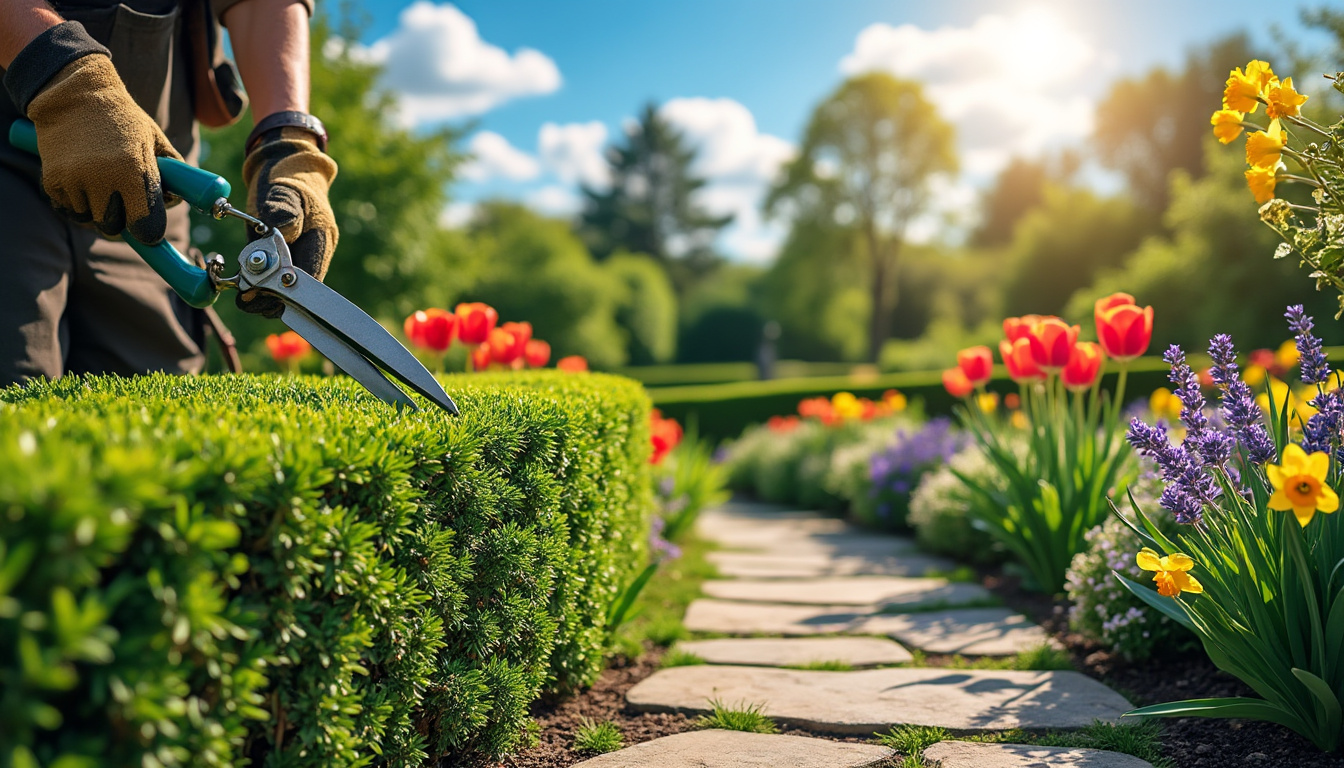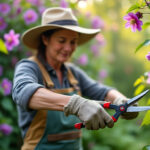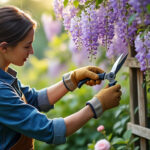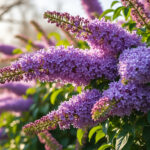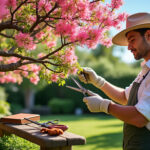This article presents a structural guide on optimizing box hedge pruning schedules to enhance growth, particularly focusing on the techniques, timing, and best practices essential for achieving a healthy and aesthetically pleasing hedge. It explores the factors influencing the pruning schedule and offers practical advice for both novice and experienced gardeners seeking to maintain robust box hedges.
- Understanding Box Hedges and Their Growth Patterns
- The Importance of Timing: When to Prune Your Box Hedge
- Essential Tools and Techniques for Pruning Box Hedges
- Post-Pruning Care for Optimal Growth
- Addressing Common Issues in Box Hedge Maintenance
Understanding Box Hedges and Their Growth Patterns
The box hedge, or Buxus sempervirens, has been a staple in gardens across the UK and beyond for centuries. Recognized for their dense foliage and versatility in shaping, box hedges contribute significantly to creating visual structure within garden designs. Their slow growth rate makes them suitable for formal settings but necessitates regular maintenance.
Box hedges grow best in well-drained soils and require adequate sunlight for optimal growth. These plants are known for their adaptability, thriving in various soil types and climatic conditions, but they are particularly sensitive to waterlogged roots. Understanding their growth patterns is essential in determining when and how to prune, ensuring that they remain robust and lush.
As gardens evolve, so do the growth patterns of box hedges. Observing the changes in density and height can inform pruning schedules. Ideally, box hedges should be pruned to encourage lateral growth that maintains density while fostering healthy, vibrant foliage.
| Growth Stage | Characteristics | Pruning Recommendation |
|---|---|---|
| Early Spring 🌱 | Active growth resumption | Light trimming to remove winter damage |
| Late Spring 🌼 | Robust growth phase | First major trim for shaping |
| Late Summer ☀️ | Secondary growth flush | Second trim to maintain shape |
| Autumn 🍁 | Preparation for dormancy | Final touch-ups before winter |
The Importance of Timing: When to Prune Your Box Hedge
Timing plays a critical role in the maintenance of box hedges. Regular pruning is not merely for aesthetic purposes; it also contributes to the overall health of the plant. As such, recognizing the ideal times for pruning is imperative for maintaining a box hedge that is both appealing and vigorous.
The first major pruning bout typically occurs in late spring, around late May to early June. This timing aligns with a period when the box hedge has completed its first flush of growth. By pruning at this stage, one encourages the consolidation of the new growth, allowing the hedge to maintain its shape while promoting robust foliage development. During this time, box hedges should be trimmed just above the growth nodes to stimulate lateral branching.
Following this initial trim, a secondary pruning can occur in late summer, usually between late August and mid-September. This prune is less intensive and primarily serves to clean up additional growth that can occur after the first trim. However, caution should be exercised to avoid cutting too late into the autumn, as new cuts may be harmed by early frosts. Proper timing not only helps in achieving the desired shape of the hedge but also prevents the onset of pests and diseases, as a well-timed prune promotes strong growth and resilience.
For gardeners aspiring to maintain a lush and healthy box hedge, the following schedule is recommended:
- 🌱 *Late Spring*: Major trim to establish shape.
- 🌼 *Mid-Summer*: Light trim to maintain density.
- 🍁 *Early Autumn*: Final tidy-up before winter.
Essential Tools and Techniques for Pruning Box Hedges
Effective box hedge pruning is highly dependent on the right tools and techniques. Preparing adequately prior to the work can lead to improved results and a healthier hedge. Selecting appropriate tools is a fundamental step that cannot be overlooked. For small box hedges, using a pair of sharp hand shears is often sufficient. However, for larger hedges, investing in electric or petrol hedge trimmers can significantly expedite the process.
Regardless of the tools used, ensuring they are clean and sharp is vital. Sharp tools provide cleaner cuts, minimizing the risk of disease transmission and promoting quicker healing for the plant. Additionally, making sure to clean tools after each use can prevent the spread of any existing diseases in the hedge.
Steps for Pruning:
- 🌿 Preparation: Clear the area of debris, making it easier to visualize the hedge and its shape.
- ✂️ Trimming Technique: Begin pruning from the bottom up to allow cuttings to fall away from the hedge.
- 📐 Shaping: Create a trapezoidal shape, wider at the base and narrower at the top, to ensure even sunlight penetration.
- 🧹 Cleanup: Remove clippings promptly to prevent disease establishment.
- 💧 Aftercare: Water and feed the hedge after trimming to support recovery and further growth.
When to harvest lavender for the best fragrance and flavor
Post-Pruning Care for Optimal Growth
Once the pruning is completed, facilitating the hedge’s recovery becomes crucial. Post-pruning care not only supports healing but also fosters optimal future growth. Providing adequate water is perhaps the most important step. This replenishes moisture lost during the trimming process and hydrates the newly exposed growth.
In addition to watering, applying a balanced granular fertilizer post-pruning can significantly enhance growth. Such nutrients support the regeneration of leaves and promote bushier growth. The timing and quantity of fertilizer application ought to follow the guidelines specified on the product packaging to avoid over-fertilizing, which can lead to weakened plants.
Regular monitoring is key in the subsequent weeks post-pruning. Watch for any signs of stress or disease, such as discoloration or wilting leaves. Addressing these issues swiftly can prevent minor problems from escalating into significant threats to the hedge’s health.
Post-Pruning Checklist:
- 💧 Adequate watering to prevent drying out.
- ✨ Application of fertilizer as per guidelines.
- 👀 Regular checks on plant health.
- 🌾 Removal of any debris or clippings near the hedge.
Addressing Common Issues in Box Hedge Maintenance
Like any plant, box hedges are susceptible to various problems that can affect their health and aesthetics. Some common issues include overgrowth, pest infestations, and disease outbreaks. Ensuring a preventive approach can mitigate these challenges effectively.
For overgrown box hedges, a process known as rejuvenation pruning may be required. This involves hard pruning over two years—cutting one side back significantly in the first year, and then repeating the process on the other side the following year. By staggering the cuts, the hedge is granted time to recover and prevents shock from heavy pruning all at once.
Key Preventative Measures:
- 🪲 Regular inspections for pests like box blight or caterpillars.
- 🚿 Ensure adequate air circulation around the hedge to avoid humidity-related diseases.
- 🛠️ Maintain tool hygiene to prevent disease transmission between plants.
- 🌳 Opt for resistant varieties if disease becomes recurrent.
Integrating these practices into routine care can promote a healthy box hedge environment and reduce the likelihood of facing severe issues. Understanding their peculiarities and growth behavior will assist any gardener in crafting a well-rounded care regimen.
Frequently Asked Questions
- What should I do if my box hedge has overgrown?
Consider rejuvenation pruning, cutting back a side by about one-third each year for two consecutive years. - How can I prevent box blight?
Ensure good ventilation, avoid excessive watering, and clean your tools regularly. - What is the best time to prune box hedges?
Late spring and late summer are generally recommended for the major trims. - How can I improve my box hedge’s growth post-pruning?
Proper watering regime and fertilizer application are crucial for recovery. - Is hard pruning safe for box hedges?
Yes, but it should be done strategically over a couple of years to minimize stress.

